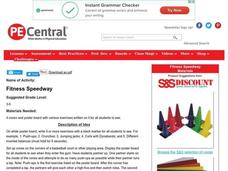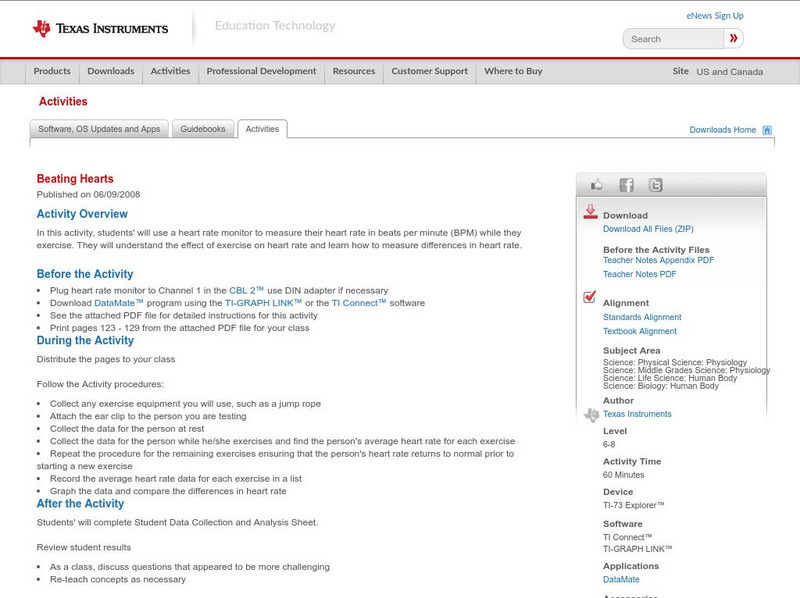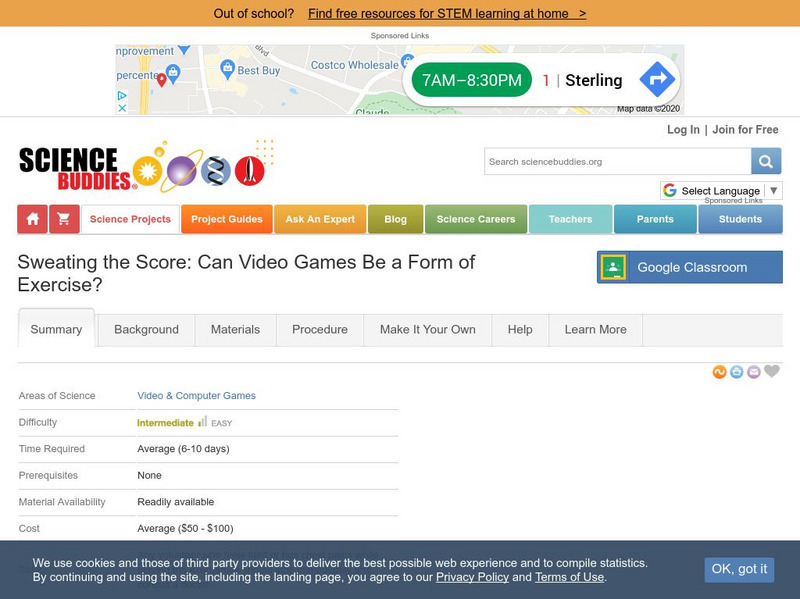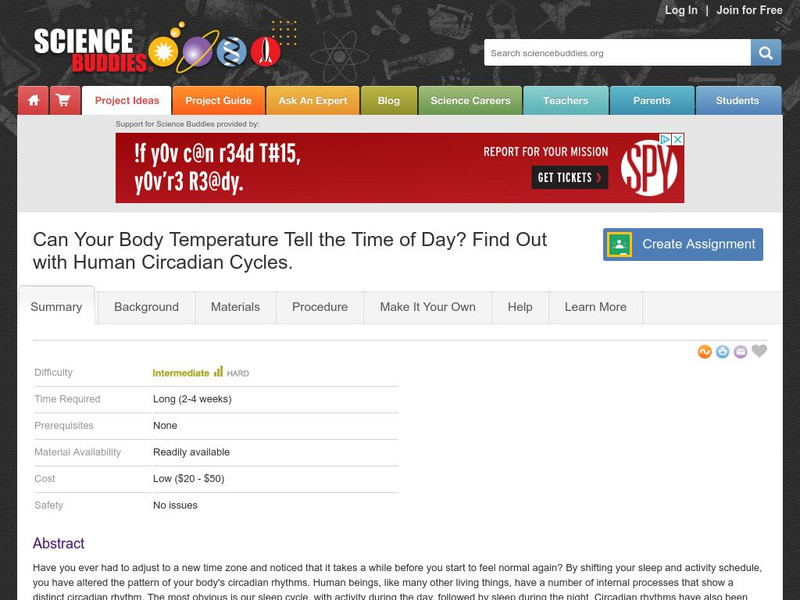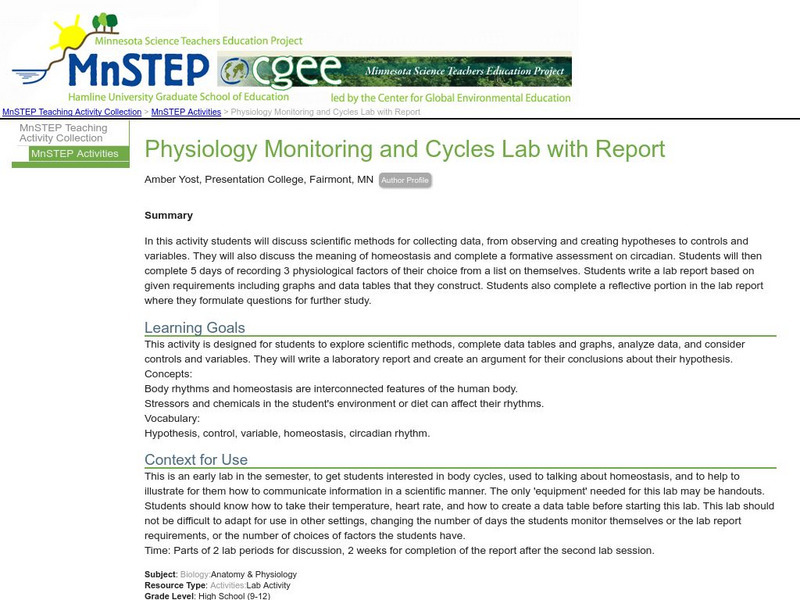Curated OER
Fitness Speedway
Young scholars participate in push-ups, crunches, jumping jacks, curls with dynabands, and different inverted balances.
Curated OER
Excuse Me
Learners participate in a game where one student is "the tagger." The tagger holds an object in their hand to signify they are the tagger. They attempt to move through the playing area attempting to tag other players with their beanbag.
Curated OER
Anatomy of the Brain
Learners explore the brain. In this science lesson, students view a diagram of the brain and discuss the various regions of the brain. Learners discuss the importance of protecting the brain and design a protective covering.
Curated OER
What's Fit to Print?
Students evaluate how newspapers are constructed and evaluate the extent to which newspapers serve their readers' interests.
BioEd Online
Bio Ed Online: Heart Rate and Exercise
In this lesson middle schoolers will measure their heart rates after a variety of physical activities and compare the results with their resting heart rates, and with the heart rates of other students in their groups.
Texas Instruments
Texas Instruments: Heart Rate and Body Position
In this activity, students can use a Heart Rate Monitor to measure their heart rate while sitting, lying down, and standing. They will analyze the data collected to determine the effect of body position on heart rate.
Science Buddies
Science Buddies: A Day in the Life of Your Heart
Heart rates can be determined by the amount of physical activity your body is engaging in. The more physically active you are, the faster your heart beats. You can measure the rate your heart is beating by taking your pulse. This science...
Science Buddies
Science Buddies: Heart Health: How Does Heart Rate Change With Exercise?
Your heart starts beating before you are born and keeps right on going through your whole life. Over an average lifetime, the human heart beats more than 2.5 billion times. Keeping your heart healthy means eating right, not smoking, and...
PBS
Pbs Learning Media: Sci Girls: Heart to Heart
In this activity, learners compare ways to measure their heart rates. They will build their own stethoscopes and learn how exercise affects heart rate.
Scholastic
Scholastic: Discussion Guide: Heartbeat
Scholastic presents this discussion guide of "Heartbeat" by Sharon Creech. The guide includes discussion questions, extension activities, and more.
Texas Instruments
Texas Instruments: Beating Hearts
In this activity, students' will use a heart rate monitor to measure their heart rate in beats per minute (BPM) while they exercise. They will understand the effect of exercise on heart rate and learn how to measure differences in heart...
TeachEngineering
Teach Engineering: The Beat Goes On
In this activity, students learn about their heart rate and different ways it can be measured. Students construct a simple measurement device using clay and a toothpick, and then use this device to measure their heart rate under...
Texas Heart Institute
Texas Heart Institute: Heart Information Center: Pacemaker
Article on arrhythmias with information about the heart's pacemaker.
National Institutes of Health
National Library of Medicine: Your Beating Heart
In this lesson plan site, the students will learn about the circulatory system and perform an experiment where they take their pulse after various activities.
Science Museum of Minnesota
Lesson Plan: Pulse of Life
Students measure their pulse rate and explore how heart rate is affected by various activities.
TeachEngineering
Teach Engineering: Artificial Heart Design Challenge
Students are presented with a hypothetical scenario in which they are biomedical engineers asked to design artificial hearts. Using the engineering design process as a guide, the challenge is established and students brainstorm to list...
National Cancer Institute at the National Institutes of Health
Seer Training Modules: Introduction to the Cardiovascular System
Self-guided learning activity where students learn about the structure and function of the human cardiovascular system. There is a short quiz at the end of the lesson to check for understanding.
Science Buddies
Science Buddies: Sweating the Score: Can Video Games Be a Form of Exercise?
The majority of video games are sedentary, meaning done in one position, but there is an increasing trend toward video games where the players are physically active. Whether or not these type of video games can be considered exercise is...
Science Buddies
Science Buddies: Can Your Body Temperature Tell the Time of Day?
If you have ever had to adjust to a new time zone, you have noticed that it takes a while before you start to feel normal again. By shifting your sleep and activity schedule, you have altered the pattern of your body's circadian rhythms....
BBC
Bbc Schools: Ks2 Bitesize: Science: Living Things: Circulation
Check Steve's cardiovascular health before he starts filming his dangerous wildlife special. Following the activity, read more about the heart, and then take a quick quiz to check for understanding.
Science Education Resource Center at Carleton College
Serc: Physiology Monitoring and Cycles Lab With Report
Using physiology monitoring, students will understand how to collect data using scientific methods in this activity. Students will also learn how to communicate the finding in a lab report. Physiology monitoring will include measuring...
TeachEngineering
Teach Engineering: Do You Have the Strength?
In this activity, students squeeze a tennis ball to demonstrate the strength of the human heart. Working in teams, they think of ways to keep the heart beating if the natural mechanism were to fail. The goal of this activity is to get...
PBS
Pbs Teachers: Drinking Straw Pulse Measurer
Measure the human pulse by counting the movements of a drinking straw attached with clay to the pulse point on the neck. Predict activities that affect pulse rate, and compare your pulse with another person's.
Other
Turnstep: Aerobics Frequently Asked Questions
At this website from Turnstep, find brief responses to several questions on aerobic activity and training, workout intensity, exercise-related injury, proper eating, and ideal weight. Questions include: "What is aerobic exercise?" "How...


